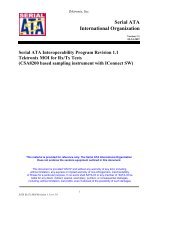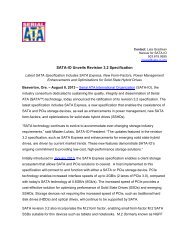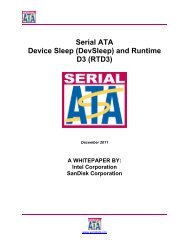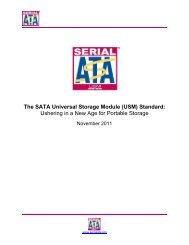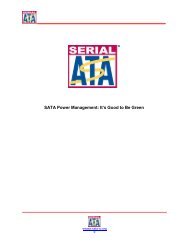1.0 - SATA-IO
1.0 - SATA-IO
1.0 - SATA-IO
Create successful ePaper yourself
Turn your PDF publications into a flip-book with our unique Google optimized e-Paper software.
Test Title: OOB-04: COMINIT/COMRESET Transmit Gap Length<br />
Test Title: OOB-05: COMWAKE Transmit Gap Length<br />
Purpose: Verify that the Product Under Test, PUT, return COMINIT/COMREST and COMWAKE with correct gap<br />
length during OOB Signaling specification of section 7.2.2.7.4, 7.2.2.7.5 and 7.4.21 of Serial ATA revision 2.6.<br />
Last Modification: March 9, 2009<br />
Discussion: This test requirement is only tested at the maximum data rates 1.5 Gb/s and 3.0 Gb/s for PUTs claiming<br />
to be capable of running. The BERTScope transmits the COMRESET/COMINT sequence of 6<br />
COMRESET/COMINIT 160 UI bursts with 480 UI gaps followed by a 45,000 UI gap and captures the 2 ms<br />
response for analysis according to sections 7.4.2.1 of the Serial ATA revision 2.6.<br />
The COMINIT/COMRESET and COMVAKE transmit gap length are measured at +100 mV and -100 mV offsets.<br />
Resource requirements and setup for OOB are shown in Appendix E.<br />
Test Procedure:<br />
1. On BERTScope select “View” then “Generator” set the “Synthesizer” to 1.5 GHz and click on the<br />
“Clock Output” icon to enable these at full rate (divide by 1),<br />
2. Click on “Pattern”, deselect “Track Detector Pattern” and click on “User Pattern” to select user pattern.<br />
Then click on “Pattern” and “Load User Pattern” to select the OOB-01_COMRESET pattern from the<br />
<strong>SATA</strong> library.<br />
3. Connect the PUT to the <strong>SATA</strong> receptacle<br />
4. Enable the Data Output + (unlink and disable the Data Output – port) at V low equal 0 V and V high equal<br />
2 V which will provide approximately 300 mV at the PUT.<br />
5. On the BERTScope select the “Eye Diagram” view. Click on “Configure” and choose “Cursors” Select<br />
the “Single Cursor” and set it at 100 mV in the center of the eye. Stop the Eye Diagram from running.<br />
Click on “Configure” and “Cursors” again and choose the cursor to be the “Sampling Point”<br />
6. Select “View” then “Editor” and “File” and click on “Capture by Length”. Enter the capture length<br />
“11,255” words when prompted. Wait until data has been collected. Scroll down to see the<br />
COMINIT/COMRESET and COMWAKE burst of the PUT response. Count the average number of<br />
UIs of respectively the COMINIT/COMRESET and the COMVAKE gaps. The BERTScope Editor<br />
conveniently groups the data into 32 bits. 5 groups therefore correspond to 160 UI and 15 groups<br />
correspond to 480 UI. It is easiest to view the additional number of UIs when using binary<br />
representation, which can be selected in the “Edit” menu.<br />
7. Repeat steps 6 through 8 above but with the threshold set to -100 mV.<br />
8. Calculate the average of the gap lengths measured at +100 mV and -100 mV and multiply with the<br />
normalized UI namely 0.675106 ns (which takes into account that the average of the burst lengths<br />
measured at +100 mV and -100 mV is 158 UI) to get the gap lengths of the PUT in ns for the OOB-04<br />
and OOB-05 measurements<br />
Observable Results: The pass/fail criteria are:<br />
OOB-04:<br />
o COMINIT/COMRESET Transmit Gap Length measured to be between 310.4 ns and 329.6 ns<br />
OOB-05:<br />
o COMVAKE Transmit Gap Length measured to be between 103.5 ns and 109.9 ns<br />
Serial ATA Logo Group 32 MOI Revision 1.3 Version <strong>1.0</strong> using BERTScope




